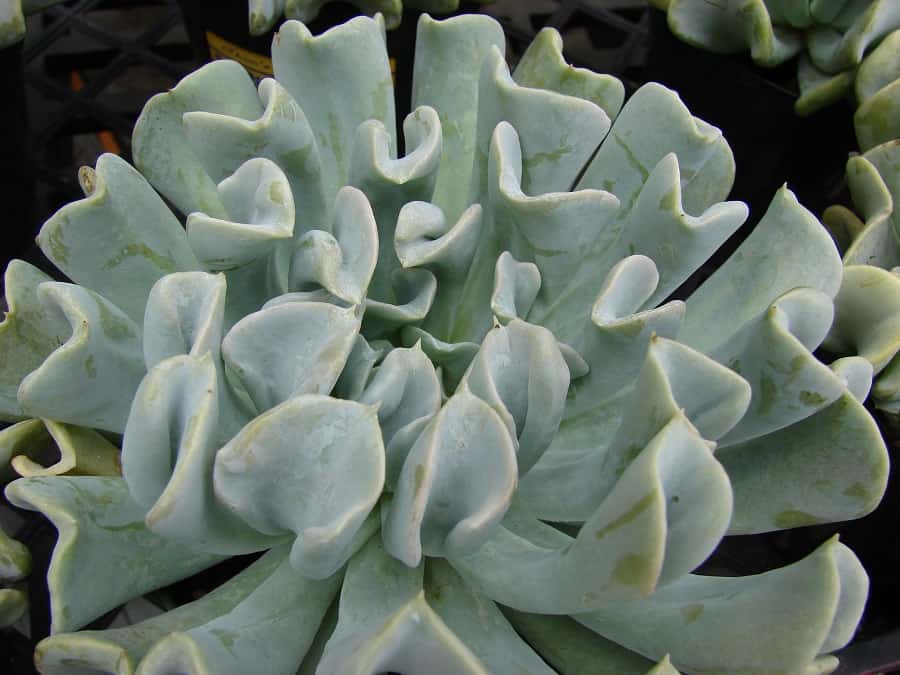Echeveria ‘Cubic Frost’ is a very beautiful succulent. This plant can measure up to 20 cm in height and approximately 25 cm in diameter.
Its leaves are lilac to pink. It is a fast-growing succulent. They grow upwards; they are also pointed, symmetrical, and fleshy.
The Echeveria ‘Cubic Frost’ blooms from spring to summer.
The flowers are orange and bell-shaped.
The rosettes can measure up to 15 cm in diameter. Its leaves can have reddish margins and a blue-green bump in each leaf.
This succulent is perfect for indoors.
Echeveria ‘Cubic Frost’ Care:
Watering:
If the succulent is in a pot, you have to be careful with excess watering to avoid possible rotting.
You should only water the substrate, never the leaves, since this causes the leaves to over hydrate and wrinkle and fall.
Avoid wetting the leaves. Never spray water on the plant.
One technique to consider, as the plant is very compact and quickly occupies the pot, is irrigation by immersion.
It is essential that you only water the plant when the substrate is completely dry.
Substratum:
The substrate for good growth could be a mixture of 1/3 sand and 2/3 leaf mulch.
Echeveria Elegans can thrive in deficient soil.
Transplant:
Like all succulent plants, it should be transplanted periodically.
Use a specific compost for cacti, to which you will add coarse river sand or perlite, in the one-to-one ratio, since they make the substrate more absorbent, facilitating the drainage of the water.
The drain hole should not be blocked.
Better to use terracotta and non-plastic pots since terracotta allows the soil to transpire and, therefore, reduce soil moisture.
You may like: Echeveria ‘Raindrops’
Fertilizer:
Succulents can obtain nutrients from their soil as long as it is adequate.
Although they do not need additive nutrition to survive, fertilizing echeverias could help them grow better once a year.
In general, spring is the best season to fertilize echeverias. They tend to grow faster and flower in that season.
Be aware, overfertilization can be harmful and can burn the plant roots, so strictly follow the directions on the label.
Temperature:
It tolerates cultivation better at high temperatures than at low temperatures. Its optimal temperature is 15°C/59°F-30°C/86°F.
Temperatures below 10°C/50°F rot roots and stems.
Plagues and diseases:
It is frequently attacked by mealybugs, aphids, and mollusks (snails and slugs).
Mealybugs and aphids must be removed manually or with specific products; they are pests capable of drying leaves and flowers.
Mollusks cause more severe damage they feed on the entire plant; use industrial pellets to control them.
Propagation:
By seeds
First, you will fill a nursery (pot, nursery tray, a milk container, … or whatever suits us best as long as it has holes in the bottom or can make holes in it) with universal culture substrate mixed with equal parts perlite.
Then you water consciously and place the seeds on the surface.
After, cover them with a thin layer of substrate and water again, this time with a sprayer.
Later, you will place the seedbed in a bright place, but never direct sunlight.
If all goes well, they will germinate in 2-3 weeks.
Leaf cuttings
Cut healthy leaves and lay them in pots with growing universal media.
After about 7 or 10 days, they will issue their own rootlets.
Transplant:
If you want to transplant the plant to the garden, do it in spring, and if you want to transplant to another pot, do it every two years.
Pruning:
It does not require pruning, just remove the damaged or dry leaves.
This is a great succulent for beginners, the only thing you have to worry about if overwatering.
